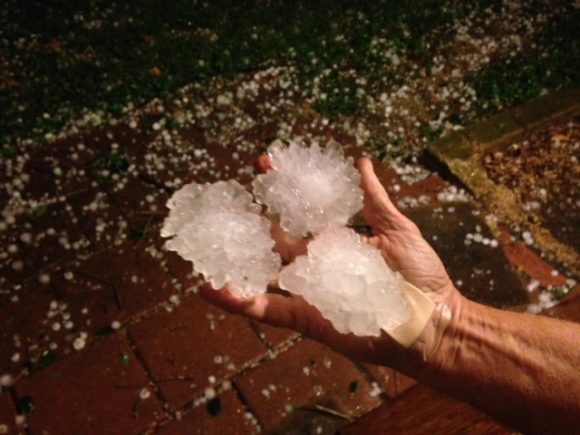According to new data released by CoreLogic, the 2016 hail season is already one of the most severe in Texas history, with year-to-date results reaching the nine-year average for U.S. hail storm damage.
Estimated losses from hail events this year in Fort Worth, Plano, Wylie and San Antonio totaled $689.6 million, CoreLogic reported.
CoreLogic pegged the Fort Worth loss at $72.5 million, losses from the Plano event at $35.8 million, losses from the Wylie hail event at $246.8 million, and losses from the San Antonio hailstorm at $334.5 million.
Fort Worth was hit with a series of powerful thunderstorms on March 17, 2016. The severe weather left a trail of destruction across the southern part of the city, where homes and businesses were blasted with wind-driven hail measuring .75 inches in diameter up to 2.25 inches. At least 236,452 homes were located in the footprint of the storms in Fort Worth.
A closer look revealed that 39.47 percent of the homes were impacted by hail of .75 inches in size, leading to an estimated $17.9 million in residential losses.
In addition, hail over 2 inches in diameter affected 12,630 homes with combined residential losses reaching upwards of $12.5 million.
In the Plano event, which occurred on March 23, parts of Denton, Collin and Dallas counties suffered downpours of hail ranging from 1.5 to 2 inches in diameter in a swath stretching nearly 50 miles in length, from near Lewisville to points east of Wylie.
The number of homes in the footprint of the Plano storms totaled 263,440. Hail ranged from .75 inches in diameter to 3.25 inches.
Hail of up to 1.5 inches in diameter impacted 31.58 percent of the homes, leading to an estimated $11.2 million in residential losses.
In addition, hail over 1.75 inches pummeled 11,301 homes with combined residential losses reaching upwards of $9.1 million.
The Wylie event occurred on April 11, when a lone supercell thunderstorm erupted near the north-central Texas town of Scotland, just to the north-west of Fort Worth. This long-lived storm began to produce copious amounts of dangerously large hail early in its life cycle, and left a path of destruction nearly 200 miles in length as it traveled east-southeast over the north Texas landscape.
Extensive property damage began as the storm entered the city of Denton, where hail up to four inches in diameter was reported.
According to CoreLogic, 310,088 homes were located in the storms’ footprint and hail measured .75 inches in diameter to 3.5 inches.
Hail of 1.5 inches impacted 17.31 percent of those homes, leading to an estimated $18.5 million in residential losses.
Hail larger than 3 inches affected 7,188 homes; combined residential losses reach upwards of $57.5 million.
On April 12, a line of severe thunderstorms formed in an unstable air mass located over portions of central Texas, near San Antonio. The southern-most cell began to reach its peak intensity as it encroached on the San Antonio metropolitan area.
The number of homes in the footprint of the San Antonio storms totaled 263,440; hail measured .75 inches in diameter to 3.25 inches.
Hail measuring up to .75 inches impacted 21.36 percent of the homes, leading to an estimated $10.8 million in residential losses.
In addition, hail larger than 3 inches affected 4,569 homes with combined residential losses reaching upwards of $36.6 million.
The Central Texas supercell struck first in the Helotes community, where it dumped hail larger than baseballs, then continued slowly across the northern half of San Antonio, damaging property at the University of Texas at San Antonio, the North Star Mall, and auto dealerships near the San Antonio airport along the way. It continued eastward across Alamo Heights and Fort Sam Houston, and consistently pounded communities with hail ranging in size from golf balls to grapefruits.
To normalize the data, CoreLogic excluded homes valued below $40,000.
For more detailed data, visit the interactive story maps online at https://CoreLogic Texas Hail Spring 2016.
Topics Texas Profit Loss Windstorm
Was this article valuable?
Here are more articles you may enjoy.



 US P/C Insurers Post Best Q1 Underwriting Result In 17 Years
US P/C Insurers Post Best Q1 Underwriting Result In 17 Years  German Insurtech Wefox to Replace CEO After Board Rejects Mubadala Sales Plan
German Insurtech Wefox to Replace CEO After Board Rejects Mubadala Sales Plan  Coverage Needed: Hundreds of Thousands in SE Now in Flood Zones With New Maps
Coverage Needed: Hundreds of Thousands in SE Now in Flood Zones With New Maps  Big ‘I’ Report: Independent Agency Channel Placed 62% of Premiums in 2023
Big ‘I’ Report: Independent Agency Channel Placed 62% of Premiums in 2023 


